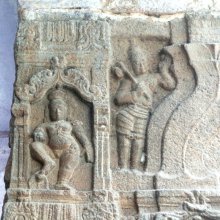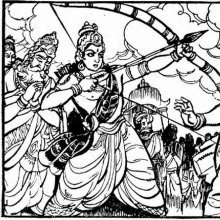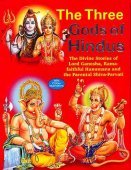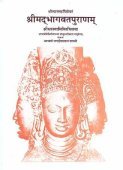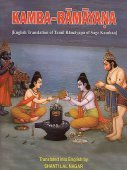Parashurama, Paraśurāma, Parashu-rama: 34 definitions
Introduction:
Parashurama means something in Hinduism, Sanskrit, Jainism, Prakrit, Marathi. If you want to know the exact meaning, history, etymology or English translation of this term then check out the descriptions on this page. Add your comment or reference to a book if you want to contribute to this summary article.
The Sanskrit term Paraśurāma can be transliterated into English as Parasurama or Parashurama, using the IAST transliteration scheme (?).
Images (photo gallery)
In Hinduism
Purana and Itihasa (epic history)
Source: Wisdom Library: Bhagavata PuranaParaśurāma (परशुराम):—The youngest of the many sons of Jamadagni (son of Satyavatī) and Reṇukā. (see Bhāgavata Purāṇa 9.15.12-13)
Source: archive.org: Puranic EncyclopediaParaśurāma (परशुराम).—An incarnation of Mahāviṣṇu, as man. Genealogy. Descending in order from Māhāviṣṇu—Brahmā-Bhṛgu-Cyavana-Ūrva-Ṛcīka-Jamadagni-Paraśurāma. (See full article at Story of Paraśurāma from the Puranic encyclopaedia by Vettam Mani)
Source: archive.org: Nilamata Purana: a cultural and literary studyParaśurāma (परशुराम) according to the Nīlamatapurāṇa.—The verses 1167-1226 give the story of Paraśurāma who eliminated twenty one times all the Kṣatriyas on the earth, to avenge the murder of his father. In the twenty first attack, he followed the Kṣatriyas to Kaśmīra and after killing them near the river Madhumatī, he erected there an image of Keśava which, as the Nīlamata informs us, was worshipped by the people, with animal sacrifices.
Source: archive.org: Shiva Purana - English TranslationParaśurāma (परशुराम) refers to the “one who exterminated the Kṣattriya” and is used to describe Viṣṇu, according to the Śivapurāṇa 2.5.16 (“The battle of the gods”).—Accordingly, as Brahmā and the Gods eulogized Viṣṇu: “[...] Obeisance to you O holy lord, of the form of Boar. Obeisance to you who hold the earth, the support of people. Obeisance to Viṣṇu. Obeisance to you, the Dwarf. Obeisance to Viṣṇu the younger brother of Indra, the lord who deceived the king of Asuras in the guise of a Brahmin. Obeisance to Paraśurāma who exterminated the Kṣattriyas, who rendered help to your mother. Obeisance to you who are angry and inimical to the evil beings. [...]”.
Source: Cologne Digital Sanskrit Dictionaries: The Purana Index1a) Paraśurāma (परशुराम).—A Siddha: the 16th avatār of Viṣṇu; a foe of the Haihayas; rid the world of the Kṣatriyas twenty one times; and made three pools of blood at Syamantapañcaka;1 defeated by Rama2 spoke highly of the valour of Bhīṣma,3 while in tapas was met by Kṛṣṇa and Balarāma on their way to Gomanta; he asked them to kill the king of Karavīrapura at its foot and thus clear the way uphill;4 was met by Balarāma;5 son of Jamadagni with an aṃsa of Nārāyana; a Bhargava;6 killed Kārtavīrya Arjuna.7
- 1) Bhāgavata-purāṇa I. 3. 20; II. 7. 22; VI. 15. 13; X. 40. 20; 82. 3; XI. 4. 21.
- 2) Ib. IX. 10. 7; chh. 15 and 16 (whole).
- 3) Ib. IX. 22. 20.
- 4) Ib. X. [52 (V) 18-30].
- 5) Ib. X. 79-12; Viṣṇu-purāṇa IV. 4. 94.
- 6) Vāyu-purāṇa 94. 38; Vāyu-purāṇa IV. 7. 36.
- 7) Viṣṇu-purāṇa IV. 11. 20.
1b) A Purohita of Kṛṣṇa in his yajñas at Kurukṣetra.*
- * Bhāgavata-purāṇa X. 90. 46[2].

The Purana (पुराण, purāṇas) refers to Sanskrit literature preserving ancient India’s vast cultural history, including historical legends, religious ceremonies, various arts and sciences. The eighteen mahapuranas total over 400,000 shlokas (metrical couplets) and date to at least several centuries BCE.
Natyashastra (theatrics and dramaturgy)
Source: archive.org: The mirror of gesture (abhinaya-darpana)One of the Daśāvatāra (Hands of the Ten Avatars of Vishnu).—Paraśurāma: the left hand on the hip and Ardha-patāka with the right.
Source: Shodhganga: Elements of Art and Architecture in the Trtiyakhanda of the Visnudharmottarapurana (natya)Paraśurāma (परशुराम) or Paraśurāmāvatāra refers to one of the Daśāvatāra (“ten incarnations”) (of Lord Viṣṇu) to which are assign various hand gestures (in Indian Dramas), according to the Viṣṇudharmottarapurāṇa, an ancient Sanskrit text which (being encyclopedic in nature) deals with a variety of cultural topics such as arts, architecture, music, grammar and astronomy.—In the Hindu scriptures, different stories are found, related to lord Viṣṇu, where we find the magnanimity of different incarnations of lord Viṣṇu. Moreover, a great influence of these ten incarnations of lord Viṣṇu (e.g., Paraśurāma-avatāra) seems to fall in the field of Dance also.

Natyashastra (नाट्यशास्त्र, nāṭyaśāstra) refers to both the ancient Indian tradition (shastra) of performing arts, (natya—theatrics, drama, dance, music), as well as the name of a Sanskrit work dealing with these subjects. It also teaches the rules for composing Dramatic plays (nataka), construction and performance of Theater, and Poetic works (kavya).
Vaishnavism (Vaishava dharma)
Source: VedaBase: Śrīmad BhāgavatamLearned scholars accept this Paraśurāma as the celebrated incarnation of Vāsudeva who annihilated the dynasty of Kārtavīrya. Paraśurāma killed all the kṣatriyas on earth twenty-one times. When the royal dynasty, being excessively proud because of the material modes of passion and ignorance, became irreligious and ceased to care for the laws enacted by the brāhmaṇas, Paraśurāma killed them. Although their offense was not very severe, he killed them to lessen the burden of the world.
Paraśurāma is the Supreme Personality of Godhead, and his eternal mission is paritrāṇāya sādhūnāṃ vināśāya ca duṣkṛtām [Bhagavadgītā (Bombay) 4.8] — “to protect the devotees and annihilate the miscreants”. To kill all the sinful men is one among the tasks of the incarnation of Godhead. Lord Paraśurāma killed all the kṣatriyas twenty-one times consecutively because they were disobedient to the brahminical culture.
Source: VedaBase: Śrīmad Bhāgavatam 9.16.26Lord Paraśurāma still lives as an intelligent brāhmaṇa in the mountainous country known as Mahendra. Completely satisfied, having given up all the weapons of a kṣatriya, he is always worshiped, adored and offered prayers for his exalted character and activities by such celestial beings as the Siddhas, Cāraṇas and Gandharvas.
Source: ISKCON Press: GlossaryParaśurāma (परशुराम).—The sixth incarnation of Lord Kṛṣṇa, who appeared in ancient times to overthrow the warrior class when they had become degraded, who destroyed twenty-one consecutive generations of lawless members of the ruling class. He taught the science of weapons to Droṇa and Karṇa.
Source: Pure Bhakti: Bhagavad-gita (4th edition)Paraśurāma (परशुराम) refers to “son of Jamadagni and Renukā and the sixth of the ten avatāras of Lord Viṣṇu mentioned in Śrī Daśāvatāra-stotram by Jayadeva Gosvāmī. He slew all the kṣatriyas of the world to give protection to the brāhmaṇas. Literally, rāma–‘one who delights’, paraśu–‘in fighting with the axe’”. (cf. Glossary page from Śrīmad-Bhagavad-Gītā).
Source: Pure Bhakti: Brhad BhagavatamrtamParaśurāma (परशुराम) refers to:—The sixth of the ten avatāras of Śrī Viṣṇu; son of Jamadagni and Renukā. (cf. Glossary page from Śrī Bṛhad-bhāgavatāmṛta).

Vaishnava (वैष्णव, vaiṣṇava) or vaishnavism (vaiṣṇavism) represents a tradition of Hinduism worshipping Vishnu as the supreme Lord. Similar to the Shaktism and Shaivism traditions, Vaishnavism also developed as an individual movement, famous for its exposition of the dashavatara (‘ten avatars of Vishnu’).
Kavya (poetry)
Source: Shodhganga: A critical appreciation of soddhalas udayasundarikathaParaśurama (परशुरम).—One of the incarnations of Viṣṇu.—As Paraśurama, the sen of Jamadagni, he after having killed the Kṣatriyas filled the ponds in Kurukṣetra with their hlood and with it gave funeral offering to his dead father.
Source: academia.edu: Gleanings from Atula’s MusikavamsaParaśurāma (परशुराम) or Jāmadagnya-Rāma is the name of an ancient Sage, according to the historical poem Mūṣikavaṃśa by Atula dealing with the royal lineage of North Kerala in roughly 1000 verses.—The Mūṣikavaṃśa begins with an account of a pregnant queen, guarded by her family priest, escaping the animosity of sage Jāmadagnya Rāma, more popularly known as Paraśurāma (‘Rāma with axe’) in the West coast of India, reaching the mountain called Eli. The queen delivers a male child who was properly educated by her priest who becomes King Rāmaghaṭa.He appoints Mahānāvika, a merchant (śreṣṭhin) from māhiṣmatī as his minister and builds Kola, the capital city of the dynasty. Crossing the Killā river, he visits the mountain and seeks the blessing of Paraśurāma. [...]

Kavya (काव्य, kavya) refers to Sanskrit poetry, a popular ancient Indian tradition of literature. There have been many Sanskrit poets over the ages, hailing from ancient India and beyond. This topic includes mahakavya, or ‘epic poetry’ and natya, or ‘dramatic poetry’.
Pancaratra (worship of Nārāyaṇa)
Source: archive.org: Isvara Samhita Vol 5Paraśurāma (परशुराम) refers to one of the various Vibhava manifestations according to the Īśvarasaṃhitā 24.341-342.—Accordingly, “He (Paraśurāma) is to be meditated upon. He cuts the trees of karman of those who are devoted to karma, which are the roots of bondage with the power of non-attachment called axe. He has two arms which bear the lustre of the rising sun wearing the bride of black antelope and whose hand is marked by a good (efficient) axe.”.
These Vibhavas (e.g., Paraśurāma) represent the third of the five-fold manifestation of the Supreme Consciousness the Pāñcarātrins believe in. Note: Kṛṣṇa is represented here more as a guide and instructor of people than as a child in Gokula.

Pancaratra (पाञ्चरात्र, pāñcarātra) represents a tradition of Hinduism where Narayana is revered and worshipped. Closeley related to Vaishnavism, the Pancaratra literature includes various Agamas and tantras incorporating many Vaishnava philosophies.
Shilpashastra (iconography)
Source: Shodhganga: The significance of the mūla-beras (śilpa)Paraśurāma (परशुराम) or Paraśurāmāvatāra refers to one the “ten incarnations of Lord Viṣṇu”, as defined according to texts dealing with śilpa (arts and crafs), known as śilpaśāstras.—The hand gestures for the daśāvatāra in dancing and iconography are similar in some cases and dissimilar in most of the cases. When the left hand is placed on the left side of the waist in ardhacandra-hasta and the right hand assumes ardhapatāka-hasta, it is paraśurāma-avatāra-hasta in dance. In images, Paraśurāma has two hands holding the paraśu (axe) in his right hand and the visiri (fan of palm leaves) in his left hand. The posture of the right hand is the same in dance and in images; but the position of the left hand is not the same.

Shilpashastra (शिल्पशास्त्र, śilpaśāstra) represents the ancient Indian science (shastra) of creative arts (shilpa) such as sculpture, iconography and painting. Closely related to Vastushastra (architecture), they often share the same literature.
Kavyashastra (science of poetry)
Source: Shodhganga: Bhismacaritam a critical studyParaśurāma (परशुराम) figures as a male character in the Bhīṣmacarita (Bhishma Charitra) which is a mahākāvya (‘epic poem’) written by Hari Narayan Dikshit.—Paraśurāma has been a Brahmakṣatriya (warrior Brahmin), the first warrior saint. His mother was a descendant of the kṣatriya-sūryavaṃśa clan that ruled Ayodhyā to which Rāma also belonged. In the later life, he gave up violence, became an ascetic and practiced penances, mainly on the Mahendra Mountains. Our poet has nicely depicted the character of Paraśurāma in the present epic. He has portrayed him as a violent temper. He was a master archer himself as well as an expert teacher of the archery.
Paraśurāma received an axe after undertaking a terrible penance to please Śiva, from whom he learned the methods of warfare and other skills. He traversed the earth twenty-one times and punished the evil-doers who were harassing the people. In ancient times, several kings who had turned into evil beings because of their royal wealth, arrogance of power, and people’s allegiance, ruled our country. They had posed a serious threat to the pious, religious and scholarly life-pursuit of those who wanted to lead a life of moral and social rectitude. It was at this time that a great man, an incarnation of God, manifested himself on the earth.
Paraśurāma achieved an adventurous, romantic and revolutionary desire. Because of his campaigns, injustice was done away with and justice established on earth. This virile, powerful and towering person picked up an axe, went round the earth twenty-one times and killed the evil Kṣatriya kings like felling trees in the forests, and thus brought solace to the people. The country again smiled with peace and prosperity. And it was as if a New World had been created. He was the ‘Guru’ (Master) of such royal stalwarts and savants as Bhīṣma and Droṇa. He was very kind and affectionate towards his disciples.

Kavyashastra (काव्यशास्त्र, kāvyaśāstra) refers to the ancient Indian tradition of poetry (kavya). Canonical literature (shastra) of the includes encyclopedic manuals dealing with prosody, rhetoric and various other guidelines serving to teach the poet how to compose literature.
Jyotisha (astronomy and astrology)
Source: Google Books: Studies in the History of the Exact Sciences (Astronomy)Paraśurāma (परशुराम) refers to an incarnation, according to the Ghaṭikāyantraghaṭanāvidhi, an unpublished manuscript describing the ritual connected with the setting up of the water clock and its invocation.—Accordingly, “[Now the pala-verses]: [...] For the welfare of the world, there [manifested the incarnations of] the Fish, the Tortoise, the Boar, the Man-Lion, One who had a Short Stature, Paraśurāma, Rāma, Kṛṣṇa, Buddha and Kalkin. I bow to Govinda, the god of gods, who in this manner assumed diverse forms, diverse shapes and diverse names, and who is meditated upon by sage”.

Jyotisha (ज्योतिष, jyotiṣa or jyotish) refers to ‘astronomy’ or “Vedic astrology” and represents the fifth of the six Vedangas (additional sciences to be studied along with the Vedas). Jyotisha concerns itself with the study and prediction of the movements of celestial bodies, in order to calculate the auspicious time for rituals and ceremonies.
General definition (in Hinduism)
Source: Wisdom Library: HinduismParaśurāma (परशुराम, “warrior with the axe”) is a Sanskrit word referring to one of the ten incarnations of Viṣṇu. This incarnation appeared in the tretāyuga. Viṣṇu is the name of a major Hindu deity and forms part of the trinity of supreme divinity (trimūrti) together with Brahmā and Śiva. They are seen as the cosmic personifications of creation (brahmā), maintenance (viṣṇu), and destruction (śiva).
He was the son of a Brahmin father Jamadagni and a Kshatriya mother Renuka. He received an axe after undertaking a terrible penance to please Shiva, from whom he learned the methods of warfare and other skills. He fought back the advancing seas thus saving the lands of Konkan and Malabar. He is said to be a Brahmakshatriya ("warrior Brahman"), the first warrior saint.
Source: Apam Napat: Indian MythologyParashurama is one of the avatars (incarnations) of Lord Vishnu. He was born as the son of the sage Jamadagni and Renuka and was named Bhargava. He was known as Parashurama because the axe was his favorite weapon. He executed his mother at the bidding of his father and later had her brought back to life. According to legend, Parashurama learnt the art of war from Lord Shiva himself. There is also a story that explains why Parashurama was so proficient in arms.
Source: WikiPedia: Hinduism1. Avatar of Viṣnu. Parashurama, Warrior with the axe, appeared in the Treta Yuga. He is son of Jamadagni and Renuka. He received an axe after a penance to Shiva. Parashurama is the first Brahmin-Kshatriya in Hinduism, or warrior-saint, with duties between a Brahmana and a Kshatriya).
2. Parshuram (Sanskrit: परशुराम, Parashurama), is the sixth avatar of Lord Vishnu, He is son of Renuka and the saptarishi Jamadagni. He lived during the last Treta Yuga, and is one of the seven immortals or Chiranjivi, of Hinduism, He received an axe after undertaking terrible penance to please Shiva, who in turn taught him the martial arts.
Parashurama is most known for ridding the world of kshatriyas twenty-one times over after the mighty king Kartavirya killed his father. He played important roles in the Mahabharata and Ramayana, serving as mentor to Bhishma, Karna and Drona. Parashurama also fought back the advancing seas to save the lands of Konkan, Malabar and Kerala.
In Jainism
General definition (in Jainism)
Source: archive.org: TrisastisalakapurusacaritraParaśurāma (परशुराम) or simply Rāma is the son of king Jamadagni and Reṇukā, according to chapter 6.4 [subhūma-cakravartin-caritra] of Hemacandra’s 11th century Triṣaṣṭiśalākāpuruṣacaritra: an ancient Sanskrit epic poem narrating the history and legends of sixty-three illustrious persons in Jainism.
Accordingly:—“[...] One day a Vidyādhara came there, suffering from dysentery. He had forgotten his magic art for going through the air because of the pain from the dysentery. He was cured by Rāma, like a brother, by medicines, etc. and gave the magic art of the axe (pāraśarī) to Rāma who had attended him. Going into a cane-field, Rāma subjugated the magic art and from that time was known as Paraśurāma. [...]”.

Jainism is an Indian religion of Dharma whose doctrine revolves around harmlessness (ahimsa) towards every living being. The two major branches (Digambara and Svetambara) of Jainism stimulate self-control (or, shramana, ‘self-reliance’) and spiritual development through a path of peace for the soul to progess to the ultimate goal.
Languages of India and abroad
Marathi-English dictionary
Source: DDSA: The Molesworth Marathi and English Dictionaryparaśurāma (परशुराम).—m (S paraśu Ax, rāma Who delights in.) A hero and demigod; the first of the three Ramas; and the sixth Avatar of viṣṇu. He appeared for the purpose of punishing the violence of the Kshatriya or military tribe.
Source: DDSA: The Aryabhusan school dictionary, Marathi-Englishparaśurāma (परशुराम).—m A hero and demigod; and the sixth Avatar of viṣṇu.
Marathi is an Indo-European language having over 70 million native speakers people in (predominantly) Maharashtra India. Marathi, like many other Indo-Aryan languages, evolved from early forms of Prakrit, which itself is a subset of Sanskrit, one of the most ancient languages of the world.
Sanskrit dictionary
Source: DDSA: The practical Sanskrit-English dictionaryParaśurāma (परशुराम).—'Rāma with the axe', Name of a celebrated Brāhmaṇa warrior, son of Jamadagni and the sixth incarnation of Viṣṇu. [While young he cut off with his axe the head of his mother Reṇukā at the command of his father when none of his other brothers was willing to do so; (see jamadagni). Some time after this, king Kārtavīrya went to the hermitage of his father, and carried off his cow. But Paraśurāma, when he returned home, fought with the king and killed him. When his sons heard this they became very angry, and repaired to the hermitage, and on finding Jamadagni alone, they shot him dead. When Paraśurāma, who was not then also at home, returned, he became very much exasperated, and made the dreadful vow of exterminating the whole Kṣatriya race. He succeeded in fulfilling this vow, and is said to have 'rid the earth thrice seven times of the royal race'. He was afterwards, destroyer of the Kśatriyas as he was, defeated by Rāma, son of Daśaratha, though quite a boy of sixteen (see R.11.68- 91). He is said to have at one time pierced through the Krauñcha mountain, being jealous of the might of Kārtikeya; cf. Meghadūta 57. He is one of the seven chirajivins and is believed to be still practising penance on the Mahendra mountain; cf. Gīt 1. :-क्षत्रियरुधिरमये जगदपगतपापं स्नपयसि पयसि शामतभवतापम् । केशव धृतभृगुपतिरूप जय जगदीश हरे (kṣatriyarudhiramaye jagadapagatapāpaṃ snapayasi payasi śāmatabhavatāpam | keśava dhṛtabhṛgupatirūpa jaya jagadīśa hare) |].
Derivable forms: paraśurāmaḥ (परशुरामः).
Paraśurāma is a Sanskrit compound consisting of the terms paraśu and rāma (राम).
Source: Cologne Digital Sanskrit Dictionaries: Shabda-Sagara Sanskrit-English DictionaryParaśurāma (परशुराम).—m.
(-maḥ) A hero and demigod; the first of the three Ramas, and the sixth Avatara or descent of the deity Vishnu: who appeared in the world as the saint Jamadagni, for the purpose of repressing the tyranny and punishing the violence of the Kshetriya, or military tribe; Parasurama appears to typify the tribe of Bramhans and their contests with the Kshetrityas. E. paraśu an axe, and rāma who delights in; also with kan added, paraśurāmaka; and with the first member, parśu, parśurāma, q. v.
Source: Cologne Digital Sanskrit Dictionaries: Benfey Sanskrit-English DictionaryParaśurāma (परशुराम).—m. the first of the three renowned Rāmas, the son of Jamadagni, [Prabodhacandrodaya, (ed. Brockhaus.)] 5, 5 (cf.
Paraśurāma is a Sanskrit compound consisting of the terms paraśu and rāma (राम).
Source: Cologne Digital Sanskrit Dictionaries: Cappeller Sanskrit-English DictionaryParaśurāma (परशुराम).—[masculine] [Epithet] of Rama (R. with the axe).
Source: Cologne Digital Sanskrit Dictionaries: Aufrecht Catalogus Catalogorum1) Paraśurāma (परशुराम) as mentioned in Aufrecht’s Catalogus Catalogorum:—son of Horilamiśra, grandson of Suryākara, prince of Yamunāpura, patron of Khaṇḍerāya (Paraśurāmaprakāśa). W. p. 312.
2) Paraśurāma (परशुराम):—Īśāvāsyopaniṣaṭṭīkā. NW. 282. Gṛhyasūtravyākhyā. NW. 10. Mahārudrapaddhati.
3) Paraśurāma (परशुराम):—Rasarājaśiromaṇi med. B. 4, 236.
4) Paraśurāma (परशुराम):—son of Kṛṣṇadeva: Pāṭīlīlāvatīvivaraṇa. B. 4, 156. Bhūpālavallabha.
5) Paraśurāma (परशुराम):—son of Karṇa, composed the Mahārudrapaddhati in 1459.
6) Paraśurāma (परशुराम):—paraśurāma, son of Śrīharsha (not of Kṛṣṇadeva, as given in Cc.): Līlāvatīṭīkā.
Source: Cologne Digital Sanskrit Dictionaries: Monier-Williams Sanskrit-English Dictionary1) Paraśurāma (परशुराम):—[=paraśu-rāma] [from paraśu] m. ‘Rama with the axe’, Name of one of the three Rāmas (son of Jamad-agni and sixth Avatāra of Viṣṇu, he was a typical Brāhman and his history typifies the contests between the Brahmans and Kṣatriyas), [Kāvya literature; Purāṇa; Monier-Williams’ Buddhism xiii, 1; Religious Thought and Life in India 110; 270] (also -ka)
2) [v.s. ...] Name of a prince and of sub voce authors (also with garjara, deva, miśra, muni), [Catalogue(s)]
Source: Cologne Digital Sanskrit Dictionaries: Yates Sanskrit-English DictionaryParaśurāma (परशुराम):—[paraśu-rāma] (maḥ) 1. m. The hero Vishnu in his 6th incarnation, when he came to punish the Kshetriyas.
[Sanskrit to German]
Sanskrit, also spelled संस्कृतम् (saṃskṛtam), is an ancient language of India commonly seen as the grandmother of the Indo-European language family (even English!). Closely allied with Prakrit and Pali, Sanskrit is more exhaustive in both grammar and terms and has the most extensive collection of literature in the world, greatly surpassing its sister-languages Greek and Latin.
Kannada-English dictionary
Source: Alar: Kannada-English corpusParaśurāma (ಪರಶುರಾಮ):—[noun] Rāma or Paraśurāma, the sixth incarnation of Viṣṇu, a person of of par-excellence strength, who, with his crescent shaped axe as his weapon, repressed or destroyed the tyrannical kings of his time.
Kannada is a Dravidian language (as opposed to the Indo-European language family) mainly spoken in the southwestern region of India.
See also (Relevant definitions)
Partial matches: Parashu, Rama, Paracu.
Starts with: Parashurama gurjara, Parashurama mishra, Parashurama muni, Parashurama shastrin, Parashuramadeva, Parashuramajayanti, Parashuramakalpasutra, Parashuramakshatra, Parashuramakshetra, Parashuramakunda, Parashuramamishra, Parashuramapaddhati, Parashuramaprakasha, Parashuramapratapa, Parashuramasahasranaman, Parashuramasutra, Parashuramavatara, Parashuramavatarakathana.
Ends with: Subhumaparashurama.
Full-text (+313): Jamadagni, Bhrigupati, Konkanasuta, Renuka, Svamijanghin, Bhargava, Krauncari, Parashudhara, Parashuramavatara, Dashavatara, Bhrigukulodvaha, Parshurama, Bhrigushardula, Bhargavaraghaviya, Bhrigudvaha, Parvatidharmaputraka, Renukatanaya, Kshatriyari, Bahusahasrabhrit, Bhrigusuta.
Relevant text
Search found 85 books and stories containing Parashurama, Paraśurāma, Parasurama, Paraśurama, Parashu-rama, Paraśu-rāma, Parasu-rama; (plurals include: Parashuramas, Paraśurāmas, Parasuramas, Paraśuramas, ramas, rāmas). You can also click to the full overview containing English textual excerpts. Below are direct links for the most relevant articles:
Garga Samhita (English) (by Danavir Goswami)
Verse 1.13.20 < [Chapter 13 - The Liberation of Pūtanā]
Verse 1.6.43 < [Chapter 6 - Description of Kaṃsa’s Strength]
Verse 1.1.17 < [Chapter 1 - Description of Śrī-Kṛṣṇa’s Glories]
The Padma Purana (by N.A. Deshpande)
Chapter 241 - Paraśurāma’s Story < [Section 6 - Uttara-Khaṇḍa (Concluding Section)]
Chapter 55 - The Birth of Lauhitya < [Section 1 - Sṛṣṭi-khaṇḍa (section on creation)]
Chapter 26 - Kurukṣetra, Pāriplava, Śalvikinī, Koṭitīrtha etc. < [Section 3 - Svarga-khaṇḍa (section on the heavens)]
The Agni Purana (by N. Gangadharan)
Chapter 4 - Manifestations of Viṣṇu as the Boar
Chapter 157 - Pollution and Purification
The Bhagavata Purana (by G. V. Tagare)
Chapter 15 - The Story of Paraśurāma—Sahasrārjuna Slain < [Book 9 - Ninth Skandha]
Chapter 13 - Description of the Future Manvantaras < [Book 8 - Eighth Skandha]
Chapter 16 - The Story of Paraśurāma (concluded) < [Book 9 - Ninth Skandha]
The Parijata of Love < [July-August, 1929]
Valmiki-Viswanatha < [April - June 1977]
Vishwanatha Satyanarayana: His Contribution < [July – Sept. & Oct. – Dec. 1992]
Diaspora of Bhuta (Daiva) worshipping cult—India and Indonesia (by Shilpa V. Sonawane)
Part 1 - The Bhuta Worship of Tulunadu < [Chapter 1 - Introduction]
Related products
